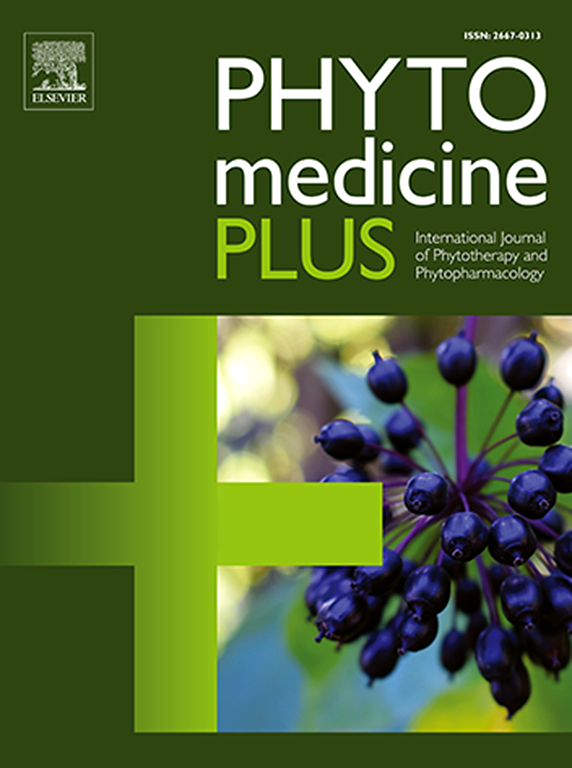阿尔茨海默病的生物标志物发现和植物化学干预:通往治疗进步的道路
Q3 Pharmacology, Toxicology and Pharmaceutics
引用次数: 0
摘要
阿尔茨海默病(AD)是当前一项重大且普遍的威胁,缺乏可获得的治疗方案。迫切需要发现新的分子标记物来诊断和治疗阿尔茨海默病。遗传生物标志物在这方面具有很大的潜力。目的本研究旨在通过整合基因表达数据和计算分析,采用一种新的策略来识别和表征AD的潜在生物标志物和治疗性植物化学物质。方法采用GEO2R进行差异表达分析,在包括内嗅皮质(EC)和后扣带(PC)在内的脑区以及外周血中鉴定出显著差异表达基因(DEGs)。利用分子对接和分子动力学模拟的计算方法研究了deg和植物化学物质之间的相互作用。结果共鉴定出BAD、CDK5、FN1、ITGA4、MAPK9等17个潜在生物标志物。根据分子对接研究,槲皮素和小檗碱与这些生物标志物显示出显著的结合亲和力,表明它们有潜力成为有效的治疗药物。ADME谱显示出良好的特性,特别是血脑屏障的渗透性。这些发现表明,所发现的生物标志物涉及与AD发展相关的重要途径,并强调了槲皮素和小檗碱作为治疗剂的潜力。结论本研究对阿尔茨海默病的分子基础有了全面的了解,并提出槲皮素和小檗碱有可能作为有效的治疗选择。这项研究为阿尔茨海默病的治疗提供了一个有希望的观点,通过关注大脑某些部位增加的蛋白质,如EC和PC,它们在导致神经变性的途径中起着至关重要的作用。本文章由计算机程序翻译,如有差异,请以英文原文为准。

Biomarker discovery and phytochemical interventions in Alzheimer's disease: A path to therapeutic advances
Background
Alzheimer's disease (AD) is a significant and prevalent threat in the current period, with a dearth of accessible treatment options. There is an urgent need to identify novel molecular markers for the diagnosis and treatment of AD. Genetic biomarkers hold promising potential in this regard.
Purpose
The study aimed to adopt a new strategy to identify and characterize potential biomarkers and therapeutic phytochemicals for AD by integrating gene expression data and computational analysis.
Methods
A differential expression analysis was conducted using GEO2R, where the significant differentially expressed genes (DEGs) were identified in brain areas that include the Entorhinal Cortex (EC) and Posterior Cingulate (PC), as well as in peripheral blood. The interactions between DEGs and phytochemicals were investigated using computational approaches that involve molecular docking and molecular dynamic simulations.
Results
A total of 17 potential biomarkers including BAD, CDK5, FN1, ITGA4, and MAPK9 were identified. Quercetin and Berberine have shown significant binding affinities to these biomarkers according to molecular docking studies, indicating their potential as effective treatment agents. The ADME profile has shown the presence of favorable properties, specifically blood-brain barrier permeability. These findings suggest that the biomarkers found are implicated in important pathways associated with the development of AD and they emphasize the potential of Quercetin and Berberine as therapeutic agents.
Conclusions
This study provides a thorough comprehension of the molecular basis of AD and proposes that Quercetin and Berberine have the potential as efficacious therapy options. This research provides a promising viewpoint on treatments for AD by focusing on proteins that are increased in certain parts of the brain, such as the EC and PC, which play a crucial role in the pathways leading to neurodegeneration.
求助全文
通过发布文献求助,成功后即可免费获取论文全文。
去求助
来源期刊

Phytomedicine Plus
Medicine-Complementary and Alternative Medicine
CiteScore
3.70
自引率
0.00%
发文量
178
审稿时长
81 days
期刊介绍:
 求助内容:
求助内容: 应助结果提醒方式:
应助结果提醒方式:


